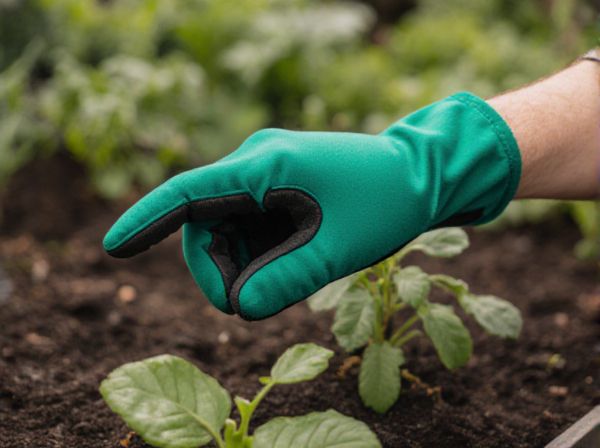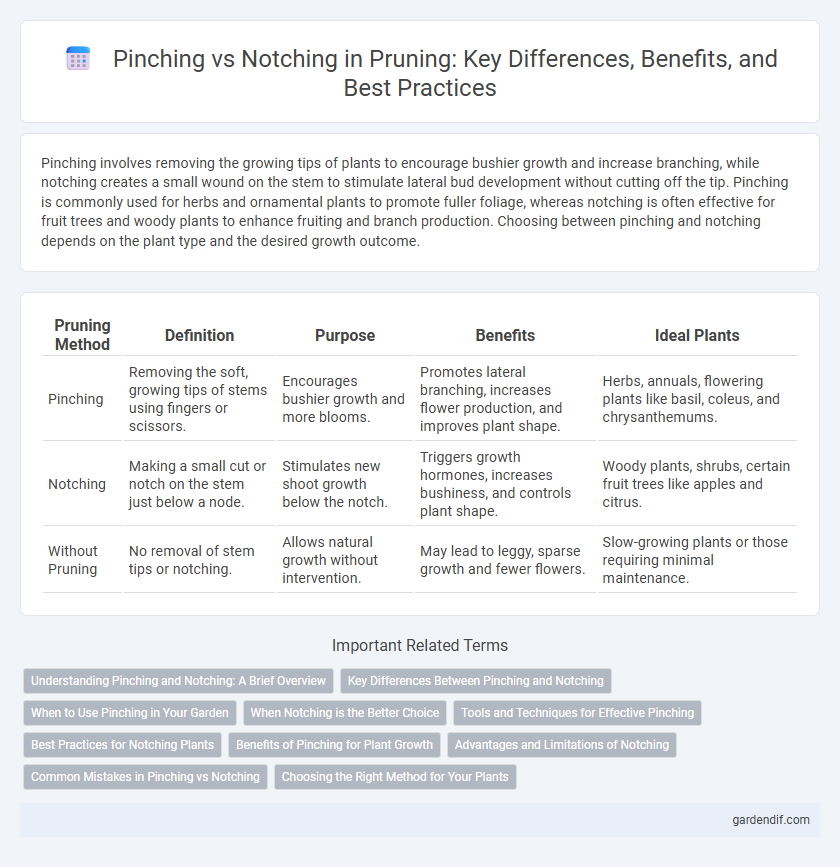
Pinching vs Notching Illustration
Pinching involves removing the growing tips of plants to encourage bushier growth and increase branching, while notching creates a small wound on the stem to stimulate lateral bud development without cutting off the tip. Pinching is commonly used for herbs and ornamental plants to promote fuller foliage, whereas notching is often effective for fruit trees and woody plants to enhance fruiting and branch production. Choosing between pinching and notching depends on the plant type and the desired growth outcome.
Table of Comparison
| Pruning Method | Definition | Purpose | Benefits | Ideal Plants |
|---|---|---|---|---|
| Pinching | Removing the soft, growing tips of stems using fingers or scissors. | Encourages bushier growth and more blooms. | Promotes lateral branching, increases flower production, and improves plant shape. | Herbs, annuals, flowering plants like basil, coleus, and chrysanthemums. |
| Notching | Making a small cut or notch on the stem just below a node. | Stimulates new shoot growth below the notch. | Triggers growth hormones, increases bushiness, and controls plant shape. | Woody plants, shrubs, certain fruit trees like apples and citrus. |
| Without Pruning | No removal of stem tips or notching. | Allows natural growth without intervention. | May lead to leggy, sparse growth and fewer flowers. | Slow-growing plants or those requiring minimal maintenance. |
Understanding Pinching and Notching: A Brief Overview
Pinching involves removing the tip of a growing shoot to encourage bushier plant growth by stimulating lateral bud development. Notching consists of making a small cut or incision just above a leaf node to disrupt auxin flow, promoting branching without removing tissue mass. Both techniques optimize plant structure, improve air circulation, and enhance light penetration, crucial for maximizing overall plant health and productivity.
Key Differences Between Pinching and Notching
Pinching involves removing the tender growth tips of plants to encourage bushier growth and increased branching, while notching entails making small cuts or slits above leaf nodes to stimulate lateral shoot development without removing entire buds. Pinching typically results in more compact, fuller plants by halting apical dominance, whereas notching promotes new growth by disrupting the downward flow of auxin hormones. Both techniques optimize plant structure and yield but differ in their methods and physiological impacts on plant hormone distribution.
When to Use Pinching in Your Garden
Pinching is ideal for herbaceous plants, vegetables, and young flowering shrubs to encourage bushier growth and increased yield by removing the growing tips early in the season. It helps redirect the plant's energy from vertical growth to lateral branching, promoting a fuller and more productive garden. Notching, on the other hand, is better suited for woody plants where you need to stimulate new shoots without removing entire tips.
When Notching is the Better Choice
Notching is the better choice when precise control over branch direction and growth is needed, especially in woody plants and fruit trees. This technique creates a small wound that disrupts nutrient flow, encouraging lateral buds to develop stronger, more balanced branches. Unlike pinching, notching is suitable for more mature branches where complete tip removal is impractical or harmful.
Tools and Techniques for Effective Pinching
Effective pinching in pruning requires precise tools such as sharp, clean fingernails or small pruning shears to remove tender shoot tips without damaging the plant. Pinching involves gently squeezing and snapping off the soft growing tips, promoting bushier growth and stronger stems, while avoiding the deeper cuts used in notching. Mastering this technique enhances plant health by ensuring minimal wound exposure and encouraging vigorous branching.
Best Practices for Notching Plants
Notching plants involves making a small cut above a node to disrupt apical dominance and encourage lateral growth, which differs from pinching that removes the growing tip. Best practices for notching include using a sharp, clean blade to create a precise incision without damaging surrounding tissues, and targeting young, actively growing stems for optimal response. Applying notching during early growth stages enhances branching and promotes a fuller, more productive plant structure.
Benefits of Pinching for Plant Growth
Pinching stimulates lateral bud development, leading to bushier plants with increased flowering sites. This technique also enhances air circulation and light penetration within the plant canopy, promoting healthier growth and reducing pest risks. Regular pinching effectively directs the plant's energy toward stronger stems and abundant blossoms, optimizing overall yield.
Advantages and Limitations of Notching
Notching offers precise control over plant growth by removing a small strip of bark, effectively disrupting auxin flow to promote lateral branching and increase yield potential. This technique is advantageous for encouraging uniform fruit development and enhancing light penetration in dense canopies. However, notching carries the risk of infection due to bark injury and requires careful timing and skill to avoid excessive stress or reduced vigor in young plants.
Common Mistakes in Pinching vs Notching
Common mistakes in pinching versus notching include removing too much of the stem during pinching, which can stunt plant growth, and placing notches incorrectly, leading to uneven branching. Many gardeners confuse the two techniques, applying pinching where notching is more effective to promote lateral shoots. Inaccurate timing and improper pressure during pinching or notching often result in plant stress and delayed development.
Choosing the Right Method for Your Plants
Pinching and notching are effective pruning techniques that stimulate plant growth by promoting lateral branching, with pinching removing the soft tip of a stem and notching creating a small cut above a node. Selecting the appropriate method depends on plant species and growth habits, as pinching suits tender, leafy plants while notching works well for woody or slower-growing varieties. Understanding plant responses to each technique ensures optimized development, improved structural strength, and increased flowering or fruit production.
Pinching vs Notching Infographic

 gardendif.com
gardendif.com